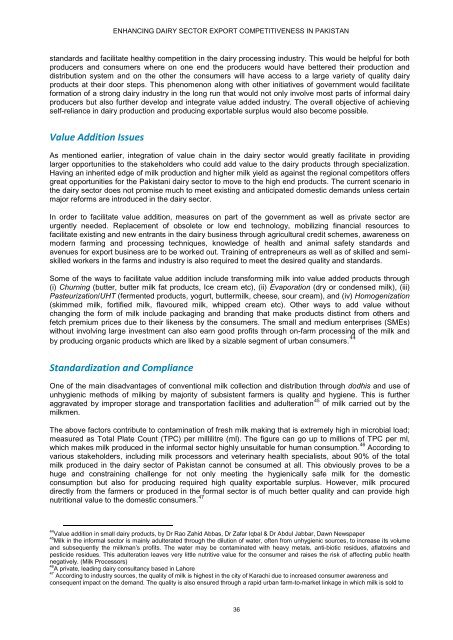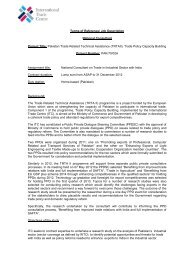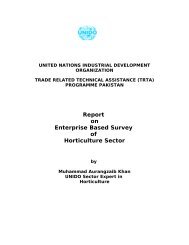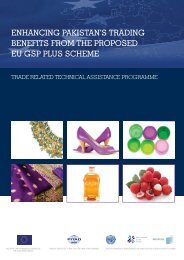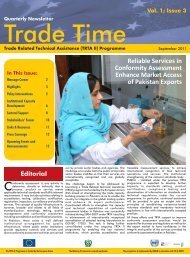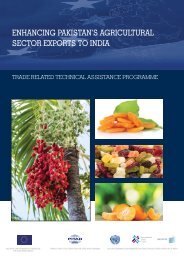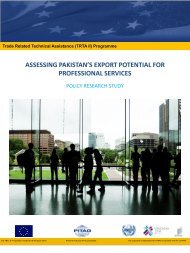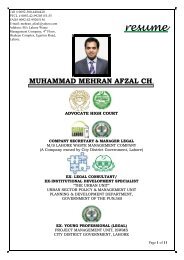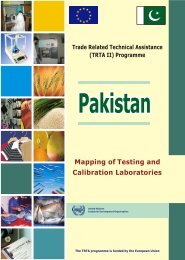Enhancing dairy sector export competitiveness - International Trade ...
Enhancing dairy sector export competitiveness - International Trade ...
Enhancing dairy sector export competitiveness - International Trade ...
Create successful ePaper yourself
Turn your PDF publications into a flip-book with our unique Google optimized e-Paper software.
ENHANCING DAIRY SECTOR EXPORT COMPETITIVENESS IN PAKISTANstandards and facilitate healthy competition in the <strong>dairy</strong> processing industry. This would be helpful for bothproducers and consumers where on one end the producers would have bettered their production anddistribution system and on the other the consumers will have access to a large variety of quality <strong>dairy</strong>products at their door steps. This phenomenon along with other initiatives of government would facilitateformation of a strong <strong>dairy</strong> industry in the long run that would not only involve most parts of informal <strong>dairy</strong>producers but also further develop and integrate value added industry. The overall objective of achievingself-reliance in <strong>dairy</strong> production and producing <strong>export</strong>able surplus would also become possible.Value Addition IssuesAs mentioned earlier, integration of value chain in the <strong>dairy</strong> <strong>sector</strong> would greatly facilitate in providinglarger opportunities to the stakeholders who could add value to the <strong>dairy</strong> products through specialization.Having an inherited edge of milk production and higher milk yield as against the regional competitors offersgreat opportunities for the Pakistani <strong>dairy</strong> <strong>sector</strong> to move to the high end products. The current scenario inthe <strong>dairy</strong> <strong>sector</strong> does not promise much to meet existing and anticipated domestic demands unless certainmajor reforms are introduced in the <strong>dairy</strong> <strong>sector</strong>.In order to facilitate value addition, measures on part of the government as well as private <strong>sector</strong> areurgently needed. Replacement of obsolete or low end technology, mobilizing financial resources tofacilitate existing and new entrants in the <strong>dairy</strong> business through agricultural credit schemes, awareness onmodern farming and processing techniques, knowledge of health and animal safety standards andavenues for <strong>export</strong> business are to be worked out. Training of entrepreneurs as well as of skilled and semiskilledworkers in the farms and industry is also required to meet the desired quality and standards.Some of the ways to facilitate value addition include transforming milk into value added products through(i) Churning (butter, butter milk fat products, Ice cream etc), (ii) Evaporation (dry or condensed milk), (iii)Pasteurization/UHT (fermented products, yogurt, buttermilk, cheese, sour cream), and (iv) Homogenization(skimmed milk, fortified milk, flavoured milk, whipped cream etc). Other ways to add value withoutchanging the form of milk include packaging and branding that make products distinct from others andfetch premium prices due to their likeness by the consumers. The small and medium enterprises (SMEs)without involving large investment can also earn good profits through on-farm processing of the milk andby producing organic products which are liked by a sizable segment of urban consumers. 44Standardization and ComplianceOne of the main disadvantages of conventional milk collection and distribution through dodhis and use ofunhygienic methods of milking by majority of subsistent farmers is quality and hygiene. This is furtheraggravated by improper storage and transportation facilities and adulteration 45 of milk carried out by themilkmen.The above factors contribute to contamination of fresh milk making that is extremely high in microbial load;measured as Total Plate Count (TPC) per millilitre (ml). The figure can go up to millions of TPC per ml,which makes milk produced in the informal <strong>sector</strong> highly unsuitable for human consumption. 46 According tovarious stakeholders, including milk processors and veterinary health specialists, about 90% of the totalmilk produced in the <strong>dairy</strong> <strong>sector</strong> of Pakistan cannot be consumed at all. This obviously proves to be ahuge and constraining challenge for not only meeting the hygienically safe milk for the domesticconsumption but also for producing required high quality <strong>export</strong>able surplus. However, milk procureddirectly from the farmers or produced in the formal <strong>sector</strong> is of much better quality and can provide highnutritional value to the domestic consumers. 4744 Value addition in small <strong>dairy</strong> products, by Dr Rao Zahid Abbas, Dr Zafar Iqbal & Dr Abdul Jabbar, Dawn Newspaper45 Milk in the informal <strong>sector</strong> is mainly adulterated through the dilution of water, often from unhygienic sources, to increase its volumeand subsequently the milkman’s profits. The water may be contaminated with heavy metals, anti-biotic residues, aflatoxins andpesticide residues. This adulteration leaves very little nutritive value for the consumer and raises the risk of affecting public healthnegatively. (Milk Processors)46 A private, leading <strong>dairy</strong> consultancy based in Lahore47 According to industry sources, the quality of milk is highest in the city of Karachi due to increased consumer awareness andconsequent impact on the demand. The quality is also ensured through a rapid urban farm-to-market linkage in which milk is sold to36


